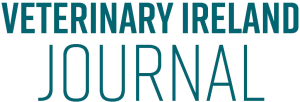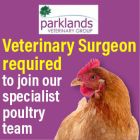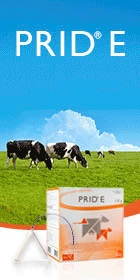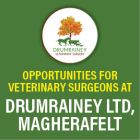Biosecurity in Irish cattle farms: a study of dairy and beef farms
Carla Gomes, DVM MSc PhD DipECVPH, pig healthCheck programme manager; Liam Doyle, MVB BSc MSc BA PhD, Johne’s Disease programme manager; and Natascha Meunier, BVSc MSc PhD, DipECVPH, Beef HealthCheck programme manager, Animal Health Ireland, outline the findings of a recent study of biosecurity on 20 dairy and 20 beef farms
Biosecurity refers to the set of measures taken to minimise the risk of introduction and spread of disease-causing agents (pathogens) on the farm (Dewulf and Van Immerseel, 2018). Pathogens can be either bacteria or viruses. Biosecurity is commonly split into external and internal components. External biosecurity includes all the measures taken to prevent pathogens entering or leaving the farm (bioexclusion and biocontainment, respectively), while internal biosecurity covers all the measures taken to limit or stop the spread of pathogens within a farm (biomanagement). Biosecurity is vital for controlling disease spread, both those that are endemic (i.e., diseases already present in the country, such as Salmonella) or exotic (i.e. disease not present in the country, such as FMD). The implementation of biosecurity measures has also been shown to have other positive effects, such as improved productivity (Osawe et al, 2022) and reduction of antimicrobial usage, which, consequently, will reduce the development of antimicrobial resistance.
The implementation of biosecurity measures needs improvement globally, with big differences between farming systems and countries. To try to fill these gaps, the “Enhanced and cost-effective biosecurity in livestock production” (BIOSECURE) project started in 2023. It involves 17 partners from 12 European countries and will run from 2023 to 2026. In Ireland the organisations involved are Animal Health Ireland (AHI) and Teagasc.
The goal of the project is to improve the ability of decision makers in livestock farming to understand, prioritise and implement evidence-based, cost effective, and sustainable biosecurity management systems in different livestock production chains. You can read more about it at https://biosecure.eu/.
The project has produced several podcasts that can be accessed at biosecure.eu/results-and-outreach/. We would highlight the podcast about “Assessment of biosecurity in cattle production” and “The link between biosecurity and sustainability” as they are of particular interest to the cattle sector.
As part of the BIOSECURE project, 20 dairy farms and 20 beef farms in Ireland were visited during November 2023 to January 2024 and questionnaires to assess their biosecurity status were employed. The questionnaires used were developed by BiocheckUGent (https://biocheckgent.com/en).
The BiocheckUGent system divides biosecurity into external and internal biosecurity and within each of these subdivides biosecurity into sub-categories. For external biosecurity the sub-categories are:
Purchase and reproduction
The introduction of new cattle through purchase is the most cited risk factor for introduction of pathogens in a herd. Although the risk of introducing pathogens depends on the frequency of purchase and type of purchased animals (e.g. young stock, breeding bull, pregnant heifers, lactating cows), every introduction of new cattle poses a risk for disease entering a herd. Therefore, the general advice is to avoid purchase of cattle as much as possible. Questions in this section are related to number and health status of the source herds, animal entry protocol, quarantine use and genetic material used.
Transport and deadstock removal
Vehicles entering the farm should also be considered when establishing a biosecurity strategy for the farm. The risk of disease transmission depends among other things on the type of vehicle: for instance, rendering company lorries are considered a higher biosecurity risk than feed company lorries. Questions in this section are related to management of cattle transport lorries and deadstock.
Feed and water
Contamination of feed with pathogens and/or (myco)toxins can occur at all stages of feed production and storage. While contamination of water can occur at the water source, in a reservoir or in the pipes and at the outlets, questions in this section are related to quality of the drinking water and storage of feed.
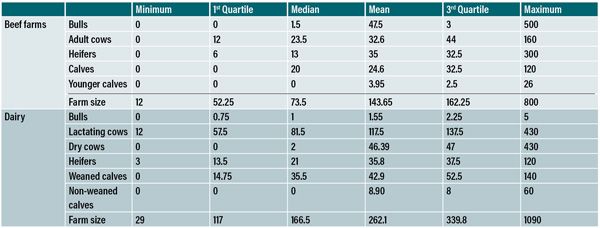
Table 1: Size of the farms (20 beef and 20 dairy) that were part of the study.
Visitors and farmworkers
Cattle farms are very often visited by different professionals. Professional visitors enter farms for work-related reasons and may thereby come into close contact with cattle. Questions in this section are related to farm visitors’ policy and hygiene measures taken by visitors when entering the farm.
Vermin control and other animals
Very often direct contact is possible between the owner’s animals and cattle from other farms, through an adjacent pasture or a common passage, constituting a high risk for disease transmission. Furthermore, disease transmission between cattle from different farms is possible when they have access to the same surface water in the pastures. The presence of rodents, insects, wild birds and stray cats are also a risk for cattle farms. Questions in this section are related to contact with other animals, and pest (rodents, insect and birds) control.
For internal biosecurity the sub-categories are:
Health management
This section has questions related to the management of sick animals, measures applied between different parts of the farm (for example, quarantine and hospital pen) and keeping records of treatments/vaccinations.
Calving management
The period around calving is a critical period for the dam, which experiences a temporary decrease in immunity. This period is also critical for the new-born calf, which is born without acquired immunity. Therefore, much attention should be paid to the calving management to avoid disease transmission through direct and indirect contact. Questions in this section are related to the use of maternity pens and the hygiene during calving.
Calf management
Since calves are born without acquired immunity, the ingestion of sufficient maternal antibodies through colostrum within the first hours of life is crucial. Questions in this section are related to colostrum management, housing and feeding of calves.
Dairy management (dairy only)
An optimal milking management plan comprises several steps. Questions in this section are related to maintenance of equipment, milking technique and milking management.
Adult cattle management
Even though adult cattle are less susceptible to disease than calves, infection pressure should be kept as low as possible. This section has questions related to management of different age groups (dairy cows) and cleaning and disinfection of sheds.
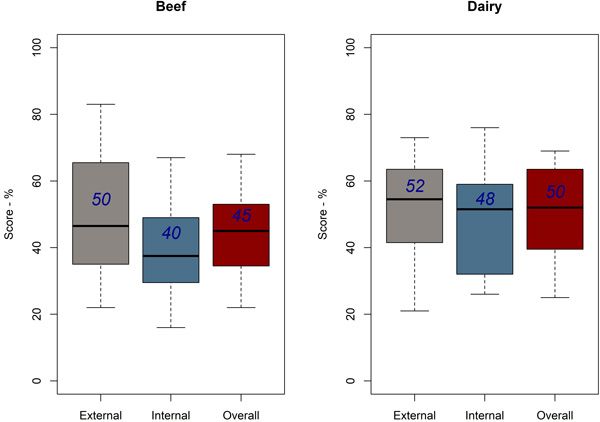
Figure 1: Boxplot of the distribution of the biosecurity scores (external, internal and overall) for 20 dairy and 20 beef farms. Average scores in blue. Scores range from 0 (poor) to 100 (excellent).
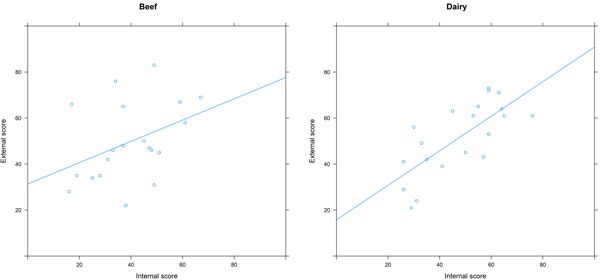
Figure 2: Distribution of scores for external biosecurity versus the scores for internal biosecurity for the 20 beef and 20 dairy farms.
Working organisation and equipment
Preferably calves and young stock should be housed in another shed away from the adult cattle, or at least well separated to avoid disease transmission through direct and indirect contact, including aerosols and air transmission. Questions in this section are related to management of different age groups (young stock versus older stock), management of materials/equipment within the farm and management of work within the farm (working lines).
The questionnaires vary from 104 questions for beef to 124 questions for dairy. A weight is attributed to each question, and they contribute to the overall score of each category. The scores vary from 0 (very poor biosecurity) to 100 (very good biosecurity). Each sub-category has a different weight (or importance) in relation to the score for external and internal biosecurity. For external biosecurity, the sub-category of “Purchase and reproduction” is considered the most important, while the most important for internal biosecurity is the sub-category “Health management”.
The farms in this study were visited by their attending veterinarian between November 2023 and January 2024. At each visit the veterinarian completed the questionnaire along with the farmer and provided three recommendations for improving biosecurity on that particular farm. Farms were chosen by the veterinarians participating in this survey.
In the rest of this article, we describe the results found in this study. To note that this was a small-scale study, more focussed on piloting the questionnaires, and is not necessarily representative of wider Irish industry, as reported in other studies ((McCarthy et al., 2021; Osawe et al, 2022).
Table 1 shows the size of the farms that have participated in this study. When comparing these results with national averages for dairy and suckler herds (www.agriland.ie/farming-news/average-dairy-and-suckler-herd-sizes-for-2022-revealed/; www.teagasc.ie/media/website/publications/2024/National-Farm-Survey-2023.pdf), the farms surveyed here had on average more cattle stock than the average dairy and beef farm in Ireland. As expected, the average dairy farm in this study had a greater number of stock than the average beef farm.
The results for these farms show that the average scores for external biosecurity were 52 and 50 for dairy and beef, respectively; while for internal the scores were 48 and 40 for dairy and beef, respectively (see Figure 1), meaning that farms are better at preventing pathogens entering or leaving the farm than limiting or stopping the spread of pathogens within a farm. There was a wide distribution of the scores between the farms in the study, for example for beef farms the external biosecurity score ranged from 22 to 83. As per average scores the medians (bold line in Figure 1) for biosecurity were higher for dairy farms compared to beef farms. Dairy farms with higher external biosecurity scores tended to have higher internal biosecurity scores (Figure 2 – right panel), suggesting that both are interlinked. The same was observed for some beef farms.
Looking in more detail to the different sub-categories that are part of biosecurity, for dairy farms (Figure 3), the following sub-categories scored below 50: Purchase and reproduction and Visitors and farmworkers (for external biosecurity), Health management, Calving management, Adult cattle management and Working organisation and equipment (for internal biosecurity). For beef farms (Figure 3), all internal biosecurity sub-categories scored below 50, while for external biosecurity Purchase and reproduction scored below 50.
Let us focus on “Purchase and reproduction” (external biosecurity), as the introduction of new cattle through purchase is the most cited risk factor for introduction of disease pathogens in a herd; and on “Health management”, as it is the category with more weight in terms of internal biosecurity; and explore the differences and similarities between the two farm types.
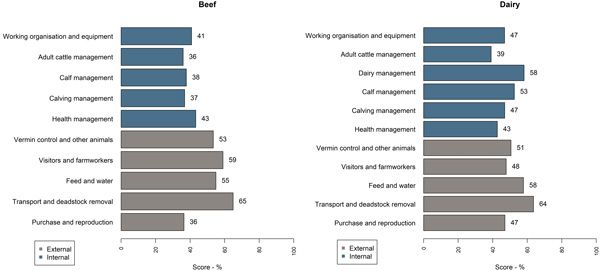
Figure 3: Average biosecurity scores per categories for external and internal biosecurity for 20 dairy and 20 beef farms.
Purchase and reproduction
Most of the dairy and beef farms in Ireland are not closed, i.e. they buy cattle with some frequency, therefore the risk of introduction of disease into the herd is higher compared to closed farms. In this study, only 20 per cent of the dairy and 10 per cent of beef farms were closed. Beef systems do tend to be more open with trading at various stages, e.g. weaning and finishing; therefore, they achieve a lower score for biosecurity compared to dairy farms. A biosecurity practice to reduce the risk of disease introduction when buying stock very often is to buy from the same source farm. However, in this study only 19 per cent of the dairy and 11 per cent of the beef farms that buy cattle always bought animals from the same source farm. Buying animals from different sources or from marts increase the likelihood of introduction of disease into a farm.
Furthermore, for most of the farms no proof in relation to the health status of the animals bought was requested by the buyer nor were the new animals tested for any specific diseases when entering the farm. Putting the new animals in quarantine before joining them with the rest of the herd was only practised in 31 per cent of the dairy and 17 per cent of the beef farms. To avoid disease transmission by fomites such as boots and clothes it is good practice to have separate clothes and boots for the quarantine area. However, this was rarely implemented in the 40 farms visited. Most of the farms (dairy or beef) that use natural service do not test the semen of their bulls for diseases.
Health management
Sick animals are the main source of infection for healthy animals and therefore should be separated from healthy animals, otherwise pathogens will carry on spreading through the farm. However, only 50 per cent of the dairy and 70 per cent of the beef farms separated sick animals from healthy animals in hospital pens. To avoid indirect transmission of pathogens through equipment (e.g. buckets, utensils), boots and clothes, it is advisable to have equipment specific for the hospital pen as well as boots and clothes. However, these were not common practices in the farms visited. Hands are also a way to transmit pathogens; therefore, hands should be washed frequently before and after tending to sick animals. This was rarely done in the farms visited. Especially when there are no specific boots/clothes in place for the hospital pen, one way of minimising the risk of pathogen transmission from sick to healthy animals is to take care of sick animals after taking care of healthy animals. This was only implemented in 45 per cent of dairy and 30 per cent of beef farms.
Health plans that include vaccination protocols, how to treat sick animals, and hygiene procedures were common on most of the farms (60 per cent and 55 per cent for dairy and beef respectively). This practice (of developing a herd health plan and reviewing it frequently) should be encouraged and implemented in all farms. Half of the dairy farms and 30 per cent of the beef farms had dedicated injection needles for specific age groups (e.g. calves, heifers, dams). Using needles between age groups increases the risk of disease transmission especially between groups of different susceptibility (e.g., calves are more susceptible to diseases than heifers).
Conclusion
This study was focused on assessing how feasible it would be to implement the BiocheckUGent questionnaire in the pasture-based Irish cattle system. Therefore, only a small number of farms were assessed (40 farms), and not randomly chosen, meaning the results from this study are not likely to be representative of Irish systems. Even so the results show that, on average, dairy farms have better biosecurity than beef farms, but there is wide scope to improve the current biosecurity status of cattle farms.
As most of the dairy and beef farms in Ireland are not closed, nor are structurally prepared to be closed farms, the focus should be in minimising the risk of introduction of disease into the farm from to newly moved on stock. Buying new stock from the same source farm and making sure that the source farm is from a higher health status than the buyers’ farm will minimise the risk of disease introduction.
To minimise the risk of disease transmission within the farm, paying more attention to how sick animals are treated can go a long way to minimise this risk. Separating the sick from the healthy animals and making sure that practices are put in place to decrease the risk of indirect disease transmission between sick and healthy animals (e.g., through boots, equipment, etc.) will decrease disease pressure on farm. Coupled with a good health plan (which should be reviewed at least annually), this will lead to further improvements of farm health status.
Biosecurity is essential for maintaining good animal health, which in return has a positive impact on farm economic outcomes. Therefore, in the future, more attention should be devoted to biosecurity.
Dewulf and Van Immerseel, 2018. “Chapter 2: General principles of biosecurity in animal production and veterinary medicine”, in Dewulf and Van Immerseel (ed.) Biosecurity in animal production and veterinary medicine. From principles to practice. Acco Leuven. ISBN 978-94-6344-378-4.
M.C. McCarthy, L. O’Grady, C.G. McAloon and J.F. Mee, 2021.
” A survey of biosecurity and health management practices on Irish dairy farms engaged in contract-rearing”, Journal of Dairy Science, Volume 104, Issue 12, 12859-12870.
Osawe, Läpple and Mee, 2022. “Economic analysis of biosecurity adoption in dairy farming: evidence from Ireland”, Journal of Animal Science, 100, 1–10.
1. The definition of biosecurity includes:
A. Minimise the risk of introduction of disease
B. Minimise the risk of spread of disease
C. Avoid spreading disease to other farms
D. All of the above
2. According to the BiocheckUgent system, external biosecurity in cattle farms includes, among others, measures related to:
A. Purchase of animals, visitors and farmworkers policy
B. Calf management
C. Management of disease
D. None of the above
3. To minimise the risk of disease introduction in open herds, which practice(s) should be followed?
A. Buy as infrequently as possible
B. Buy animals from the same source farm
C. Buy animals from a farm with higher health status than the buyer’s farm
D. All of the above
4. Sick animals are the main source of infection for healthy animals, therefore which practice(s) should be followed to manage this risk?
A. Put sick animals in a hospital pen
B. Have equipment and boots for exclusive use of the hospital pen
C. Take care of healthy animals first before taking care of sick animals
D. All of the above
ANSWERS: 1D; 2A; 3D; 4D.
